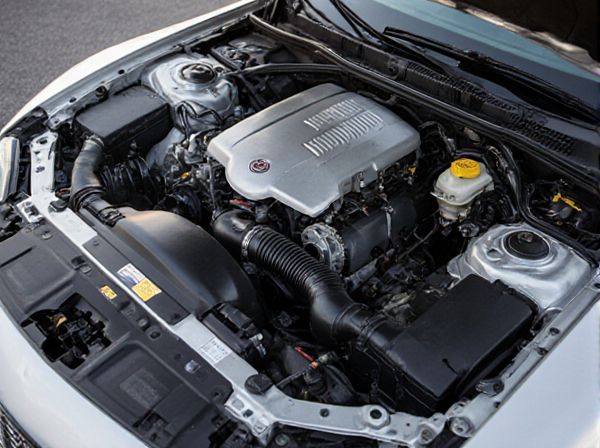
Photo illustration: Boxer Engine vs Inline Engine
Boxer engines feature horizontally opposed cylinders that provide a lower center of gravity, enhancing vehicle stability and handling. Inline engines arrange cylinders in a straight line, offering simplicity in design, compactness, and easier maintenance. Your choice depends on prioritizing performance characteristics or mechanical simplicity for your vehicle.
Table of Comparison
| Feature | Boxer Engine | Inline Engine |
|---|---|---|
| Configuration | Horizontally opposed pistons | Single straight line pistons |
| Center of Gravity | Low, balanced for better handling | Higher, less balanced |
| Vibration | Reduced, smoother operation | More vibration, uneven firing |
| Size & Packaging | Wider, lower profile | Taller, compact width |
| Cooling Efficiency | Better airflow, efficient cooling | Moderate airflow, standard cooling |
| Maintenance | Complex, harder access | Simple, easier access |
| Common Use | Sports cars, Subaru, Porsche | Most passenger cars, trucks |
| Power Delivery | Smooth, linear torque | Variable, dependent on cylinder count |
Introduction to Boxer and Inline Engines
Boxer engines feature horizontally opposed cylinders that move in and out like a boxer's fists, offering a lower center of gravity and improved balance compared to inline engines. Inline engines arrange cylinders in a straight line, providing a compact design that simplifies manufacturing and maintenance. Both engine types influence vehicle dynamics and performance, with boxer engines enhancing stability and inline engines optimizing space efficiency.
Key Differences in Engine Architecture
Boxer engines feature horizontally opposed cylinders positioned in two banks on opposite sides of the crankshaft, delivering a low center of gravity and enhanced balance, while inline engines arrange cylinders sequentially in a single row, resulting in a more compact design. The boxer engine's flat layout allows for reduced vibration and improved handling dynamics, contrasting with the inline engine's simpler construction that facilitates easier maintenance and manufacturing. Key differences include the boxer engine's wider engine bay footprint and smoother power delivery versus the inline engine's taller profile and often higher torque output at low RPM.
Performance Comparison: Boxer vs Inline
Boxer engines deliver a lower center of gravity and improved balance due to their horizontally opposed cylinder layout, enhancing vehicle stability and handling. Inline engines, typically more compact and simpler in design, offer smoother power delivery and easier maintenance but may have higher vibration levels compared to boxer engines. Performance-wise, boxer engines excel in sports cars requiring agility, while inline engines dominate in efficiency and scalability across various vehicle segments.
Weight Distribution and Vehicle Handling
Boxer engines feature a low center of gravity and even weight distribution due to their horizontally opposed cylinders, enhancing vehicle stability and cornering performance. Inline engines, positioned vertically, tend to concentrate weight higher and more centrally, which can negatively affect handling dynamics. The balanced layout of boxer engines improves traction and reduces body roll, making them preferable for sports cars and vehicles prioritizing precise handling.
Efficiency and Fuel Consumption
Boxer engines offer lower center of gravity and better balance, contributing to smoother operation and potentially improved fuel efficiency under steady conditions due to reduced engine vibration. Inline engines, commonly designed with fewer moving parts, tend to be lighter and more compact, which can result in better fuel economy during variable driving cycles. Overall, the fuel consumption differences depend on specific vehicle design and tuning, but inline engines often excel in urban efficiency while boxer engines provide enhanced stability and efficiency in performance-oriented driving.
Maintenance and Reliability Factors
Boxer engines feature horizontally opposed cylinders that provide better balance and reduce vibration, leading to enhanced reliability and less wear on engine components over time. Inline engines, with cylinders arranged in a straight line, often have simpler designs that facilitate easier and more cost-effective maintenance due to fewer moving parts and easier access. Both engine types offer strong reliability, but Boxer engines may require more specialized maintenance, whereas inline engines benefit from widespread familiarity and availability of parts.
Cost Considerations: Production and Repairs
Boxer engines typically incur higher production costs due to their complex design and horizontally opposed cylinder layout requiring specialized manufacturing processes. Repair expenses for boxer engines also tend to be greater because of limited availability of parts and the need for skilled technicians familiar with the engine's unique configuration. In contrast, inline engines boast lower production costs from simpler assembly and widespread use, with repairs generally more affordable thanks to easier access and abundant parts supply.
Common Applications in Automotive Industry
Boxer engines, characterized by their horizontally opposed cylinders, are commonly used in Subaru and Porsche vehicles due to their low center of gravity, enhancing stability and handling. Inline engines, with cylinders arranged in a straight line, are prevalent in many mainstream cars from manufacturers like Toyota and Ford for their compact design and ease of manufacturing. Both engine types serve distinct purposes, with boxer engines favored in performance and sports cars, while inline engines dominate in economy and mid-range vehicles.
Pros and Cons: Boxer Engine vs Inline Engine
Boxer engines provide a lower center of gravity and improved vehicle stability due to their horizontally opposed pistons, but they tend to be wider and more complex to manufacture compared to inline engines. Inline engines offer a more compact design, easier maintenance, and cost-effectiveness, although they may generate more vibration and have a higher center of gravity. Choosing between the two depends on priorities like handling performance and packaging constraints in automotive design.
Which Engine Type is Right for You?
Boxer engines deliver a low center of gravity and smooth operation, making them ideal for sports cars and vehicles requiring precise handling, while inline engines offer a simpler design with fewer moving parts, resulting in easier maintenance and better fuel efficiency. Consider a boxer engine if you prioritize balanced weight distribution and performance, but opt for an inline engine if you seek cost-effective repairs and reliable everyday driving. Evaluating your driving needs and maintenance preferences helps determine which engine type best suits your lifestyle.
 caratoz.com
caratoz.com